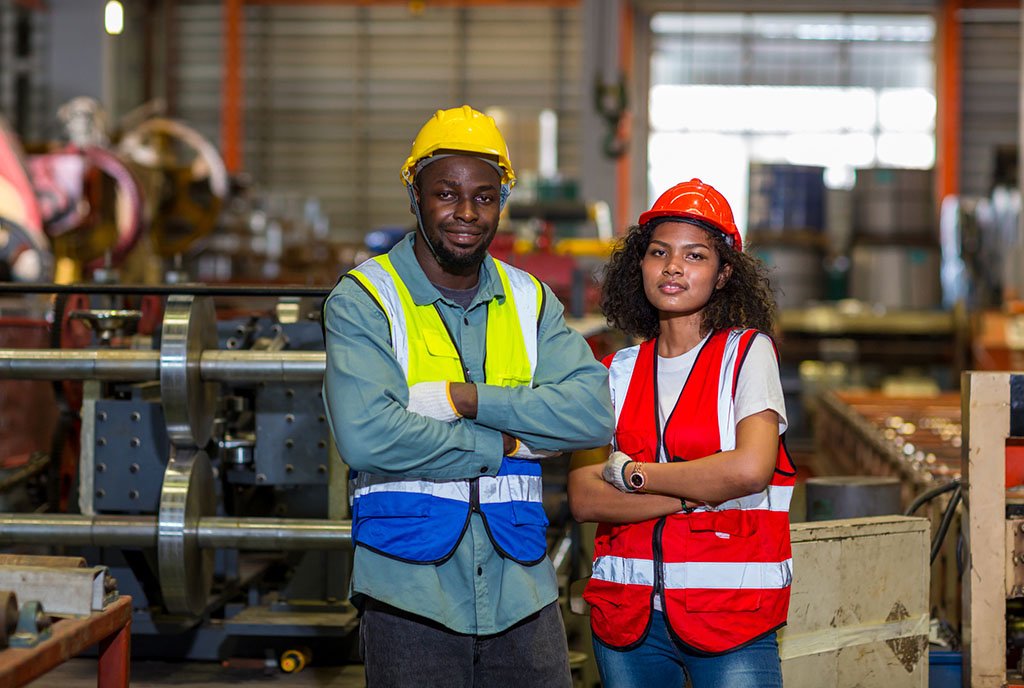
This article is the second in a four-part series, Defying the Odds: How Southern Workers Organize, a coproduction of NPQ and the LIFT Fund. In this series, authors share some compelling ways that workers are successfully organizing and why these efforts merit widespread support.
When former Acting Secretary of Labor Julie Su celebrated newly unionized workers on the floor of Alabama’s New Flyer bus manufacturing plant in June 2024, it marked one victory in a growing number of innovative efforts to ensure that no one is left behind in the South’s burgeoning clean energy economy.
Today, the South is fast becoming the epicenter of a boom of clean energy jobs fueled largely by the Inflation Reduction Act (IRA) of 2022, the single largest investment in clean energy in US history. According to the Labor Energy Partnership, the IRA alone could add nearly 1.5 million jobs and $250 billion to the economy by 2030, increase per capita personal income by thousands of dollars, and reduce greenhouse gas emissions by nearly 40 percent.
And a large portion of these dollars were disbursed before the new administration of Donald Trump took office. Indeed, one study estimates that since 2018, the South has already received $428 billion of public and private investment dollars in solar, wind, zero-emission vehicles, and other clean energy technology—more than any other region in the country.
Today, the South is fast becoming the epicenter of a boom of clean energy jobs.
Our organizations, Jobs to Move America (JMA) and Tennessee for All (TFA), are proud to play a role in holding corporations accountable through deep coalition building and meaningful policy change in a region that was built on the free labor of enslaved Black people, sustained after the Civil War by anti-union laws that disproportionately entrenched Black and Brown communities in a brutal cycle of poverty.
Making New Jobs Good Jobs in Anniston, Alabama
As a research and policy group, JMA identified the early opportunity for IRA funding to improve workers’ lives in 20,000-person Anniston, AL. The northeast Alabama town is home to New Flyer, North America’s largest manufacturer of heavy-duty transit buses, where locals build, paint, and test zero-emission electric battery and fuel-cell technology.
JMA partnered with workers and a broad coalition of community leaders to explore how these jobs could be good jobs and how New Flyer could be responsive to a broad swath of Anniston’s working-class challenges. The Anniston community united around the reality that changing workers’ experiences was vital to overcoming food and housing insecurity and other barriers they faced.
Common manufacturing job issues such as workplace safety and ways to address complaints also emerged from community conversations. Other concerns included barriers that prevented locals from getting in the door at New Flyer. In a state where 58 percent of prison inmates are incarcerated for property and drug offenses and where one-fourth of the state’s entire general fund budget goes to incarceration, Anniston had its share of system-impacted individuals who did not meet New Flyer’s hiring criteria. Women, workers of color, and immigrants were also underrepresented at the electric bus manufacturer.
The coalition also made it clear that it wanted New Flyer to emerge as a better company and was looking for a win–win solution.
In 2022, this happened with a historic community benefits agreement (CBA) between New Flyer and JMA that included measurable hiring and promotion goals to clear a path for historically disadvantaged groups in Anniston and at the company’s Ontario, CA, plant. The agreement also created an apprenticeship program, an innovative system for workers to file discrimination and harassment claims with an independent advocate—the Alabama chapter of the NAACP—and a dispute resolution process.
Union Contract for New Flyer Workers
The New Flyer community benefits agreement was the bridge for workers to unionize in Alabama, a so-called right to work state where just 7.5 percent of wage and salary workers have a union. Once New Flyer agreed to adopt a neutral position on unionization and to voluntarily recognize unions with majority support, workers had a clearer path to joining the International Union of Electronic, Electrical, Salaried, Machine and Furniture Workers, an industrial division of the Communications Workers of America (IUE-CWA).
A 2022 Bloomberg Law study found that the average time it takes a union to achieve a first contract is 465 days, a delay that almost entirely benefits employers. By contrast, New Flyer workers voted to unionize in January 2024 and ratified their first contract four months later. Highlights of that contract include 15 percent to 38 percent pay raises by 2026, forced overtime restrictions, expanded paid time off, and parental leave.
In the past, organizers would drop into communities, knock on doors, and hand out [union membership] cards….Now, national unions are engaging differently.
According to the CWA, “More than 1,150 New Flyer employees have formed unions…at facilities in Anniston, Alabama; Shepherdsville, Kentucky; and Jamestown, New York.” That is in addition to 1,200 unionized New Flyer workers in St. Cloud and Crookston, MN. Former Secretary Su highlighted New Flyer as an example of how clean air, public transportation, strong infrastructure, and good jobs can coexist.
Sign up for our free newsletters
Subscribe to NPQ's newsletters to have our top stories delivered directly to your inbox.
By signing up, you agree to our privacy policy and terms of use, and to receive messages from NPQ and our partners.
Rodney, a New Flyer worker, is just one example of the agreement’s impact. He is a system-impacted person whose leadership in his community and the CBA led to a good job and a union contract. That is the model JMA is trying to make the norm: Every family should be protected by a community benefits agreement and a collective bargaining agreement.
Holding Ford Accountable in Blue Oval City
In West Tennessee, 300 miles northwest of Anniston, the community is banding together to hold another electric battery manufacturer accountable for good jobs. The 600-person farming community of Stanton, TN, first chartered in the 1880s, is the future home of “Blue Oval City,” a $5.6 billion sprawling campus where Ford Motor Company will “reimagine how electric vehicles and batteries are designed, built and recycled,” according to a company press statement. The plant is expected to create 6,000 jobs.
When news of the auto manufacturer’s plans went public, Blue Oval Good Neighbors, a community coalition, began to organize and explore how the West Tennessee community could also benefit from Ford’s “largest, most advanced, most efficient auto production complex in its 118-year history.”
The community raised wide-ranging concerns about the megadevelopment’s impact, including increased housing costs, displacement, and effects on clean air and water. Some were also concerned about being lowballed on prices for their land, and others wanted a clear pathway to the new jobs at the campus. The coalition is also clear about the potential perpetuation of the disproportionate impact of systemic racism on West Tennessee’s Black communities, which have lower household incomes and higher poverty rates than majority White counties.
Blue Oval Good Neighbors’ work comes at a time when Tennessee’s workers have had more momentum than they have in a while on and off the job site. In 2018, a partner coalition, Stand Up Nashville (SUN), successfully negotiated a community benefits agreement with Nashville Soccer Holdings after it became the site of Major League Soccer’s fourth expansion team and after Nashville gave the team owner $275 million in subsidies for a new stadium. Some of the highlights of the agreement included a $15.50 wage floor, affordable housing on the development site, and a pipeline to construction careers for people with barriers to employment.
More recently, in 2024, 4,300 Volkswagen workers in Chattanooga and workers at the Spring Hill, TN, battery cell maker Ultium voted to unionize. The United Auto Workers represents workers at both sites.
This momentum was not created by happenstance. Each effort was bolstered by a shift in how national labor unions engaged in Tennessee. In the past, organizers would drop into communities, knock on doors, and hand out cards for workers to sign in support of a union. This transactional approach did not yield the deep, trusting relationships that are especially vital in the anti-union South. Now, national unions are engaging differently.
Black and Brown movement leaders…are building authentic and deep infrastructure and driving future solutions.
The wave of organizing is continuing this year. In January 2025, a supermajority of BlueOval SK workers in Glendale, KY, filed a petition with the National Labor Relations Board for a vote to form their union.
Today, the West Tennessee community is still calling for the Ford Motor Company to come to the table to ensure that the company does not reinforce historic racism in Blue Oval City. The community demands that the automaker agree to environmental protections, invest in and hire local workers, create affordable housing, and pay fairly for residents’ land. In August 2024, Ford announced that it was pushing back the launch of its new electric truck two years later to the second half of 2027. That truck will be assembled in Blue Oval City. The community’s engagement keeps growing.
A Call for Investment in the Future
In a region where only 6 percent of workers are union members, JMA’s goal of two CBAs—a collective bargaining agreement at work and a community benefit agreement for the neighborhood in every home—would transform towns like Anniston and Stanton. It will take playing the long game to get there, but the South is rich with Black and Brown movement leaders who are building authentic and deep infrastructure and driving future solutions. But they need long-term support from philanthropy, nonprofit partners, and labor unions.
Despite Trump administration threats to IRA and other clean energy funding, we remain optimistic that workers can leverage existing clean energy investments to advance economic equity and break the cycle of systemic racism in the South. It is happening in our states and many others through strong and inclusive community partnerships where marginalized people build power.
After centuries of oppression, this will not happen overnight, but every victory strengthens the foundation for the next. Our work is also never ending. As civil rights leader A. Philip Randolph said, “Justice is never given; it is exacted and the struggle must be continuous for freedom is never a final fact.”









